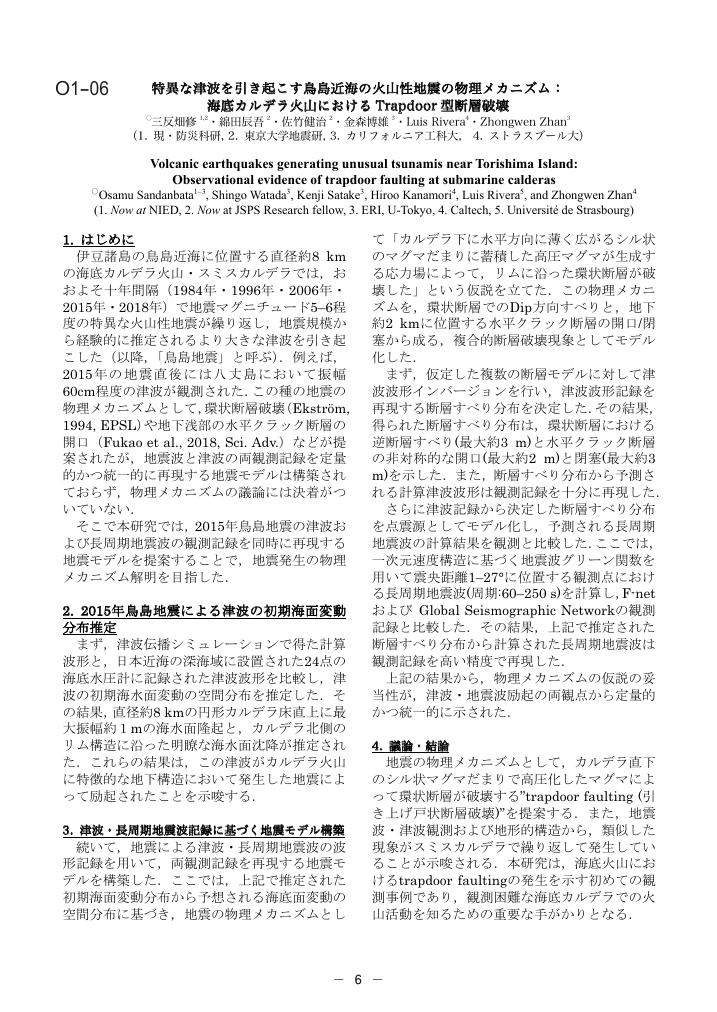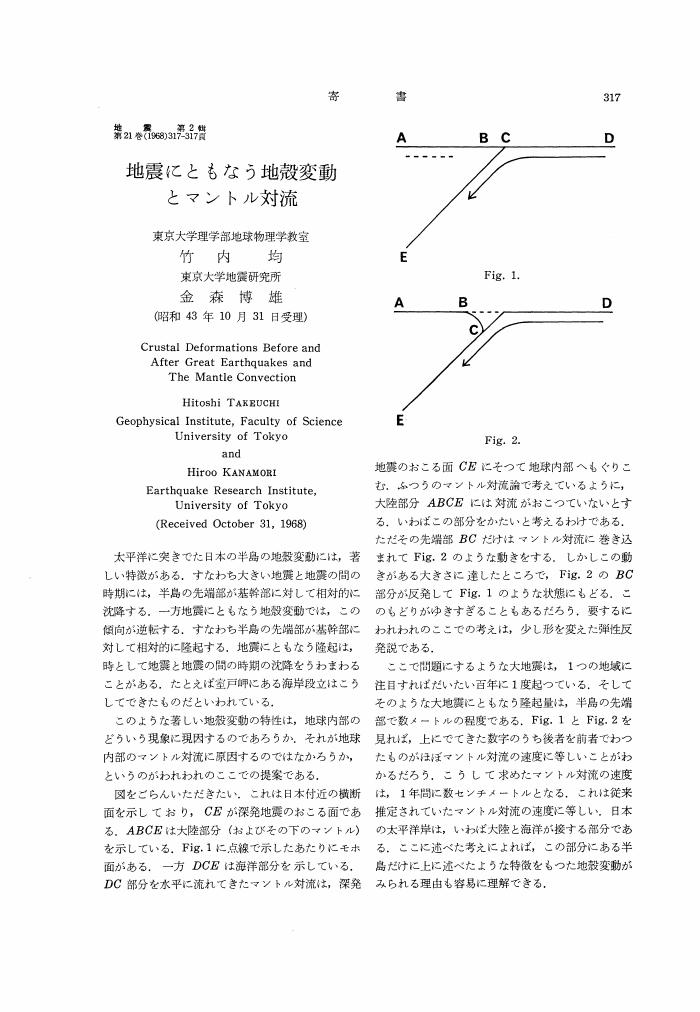- 著者
- 三反畑 修 綿田 辰吾 佐竹 健治 金森 博雄 Luis Rivera Zhongwen Zhan
- 出版者
- 特定非営利活動法人 日本火山学会
- 雑誌
- 日本火山学会講演予稿集 2020 (ISSN:24335320)
- 巻号頁・発行日
- pp.6, 2020 (Released:2021-02-01)
3 0 0 0 IR 関東地震(1923年)の断層モデル〔英文〕
- 著者
- 金森 博雄
- 出版者
- 東京大学地震研究所
- 雑誌
- 東京大学地震研究所彙報 (ISSN:00408972)
- 巻号頁・発行日
- vol.49, no.1, pp.13-18, 1971-09
- 被引用文献数
- 3
The fault parameters of the Great Kanto earthquake of September 1, 1923, are determined on the basis of the first-motion data, aftershock area, and the amplitude of surface waves at teleseismic stations. It is found that the faulting of this earthquake is a reverse right-lateral fault on a plane which dips 34° towards N20°E. The auxiliary plane has a dip of 80° towards S55°E. This means that the foot-wall side moves approximately north-west with respect to the hanging wall side. The strike of the fault plane is almost parallel to that of the Sagami trough, and the slip direction is more or less perpendicular to the trend of the Japan trench. This earthquake is therefore considered to represent a slippage between two crustal blocks bounded by the Sagami trough. A seismic moment of 7.6×1027 dyne-cm is obtained. If the fault dimension is taken to be 130×70 km2, the average slip on the fault plane and the stress drop are estimated to be 2.1m and 18 bars respectively. This slip is about 1/3 of that estimated from geodetic data. This discrepancy may indicate an existence of a pre-seismic deformation which did not contribute to the seismic wave radiation, but the evidence from other observations is not very firm.|関東地震の断層パラメターをP波の初動分布と長周期表面波の振幅からきめた.その結果,この地震はN20°Eの方向に34°傾いた面上での右ずれ・逆断層であらわされることがわかつた.断層面の大きさを130×70km2とすると,断層面上でのすべりは約2m, stress dropは18バールである.断層上でのすべりのむきが相模troughの走向に平行で,日本海溝に垂直であり,また震源が浅く(地殻内)かつ日本海溝から遠くはなれていることを考ると,関東地震は海と陸のリゾスフィアの相互作用の直接の結果とは考えにくい.むしろ,この地震は海と陸のリゾスフィアの相互作用によつて2次的に起つた,相模troughを境とする二つの地塊のずれによるものであると解釈できる.地殻変動の大きさから推定されているすべりの大きさは7mであるが,これは表面波の振幅から推定された値2mよりはるかに大きい.この違いは種々の誤差を考慮にいれてもなお有意義と思われる.このくいちがいは,全体の地殻変動量のうち2分以内の時定数をもつもののみが地震波の発生に関与したと考えれば説明できる.
2 0 0 0 OA 地震にともなう地殻変動とマントル対流
- 著者
- 竹内 均 金森 博雄
- 出版者
- 公益社団法人 日本地震学会
- 雑誌
- 地震 第2輯 (ISSN:00371114)
- 巻号頁・発行日
- vol.21, no.4, pp.317-317, 1969-02-25 (Released:2010-03-11)
- 被引用文献数
- 1
- 著者
- 三反畑 修 綿田 辰吾 佐竹 健治 金森 博雄 Luis Rivera Zhongwen Zhan
- 出版者
- 特定非営利活動法人 日本火山学会
- 雑誌
- 日本火山学会講演予稿集 (ISSN:24335320)
- 巻号頁・発行日
- vol.2020, pp.6, 2020
1 0 0 0 OA 海底カルデラ火山で繰り返す火山性津波地震(1):物理メカニズム
- 著者
- 三反畑 修 綿田 辰吾 佐竹 健治 金森 博雄 Rivera Luis Zhan Zhongwen
- 雑誌
- JpGU-AGU Joint Meeting 2020
- 巻号頁・発行日
- 2020-03-13
1. IntroductionAnomalous volcanic earthquakes repeatedly occurred about once every decade at submarine calderas near Torishima Island in Japan (Torishima earthquakes) [e.g. Fukao et al., 2018, Sci. Adv.] and near Curtis Island in New Zealand [Sandanbata et al., 2019, JpGU]. Despite their moderate seismic magnitudes Mw 5-6, the earthquakes generated disproportionately large tsunamis. Their moment tensors were dominated by non-double-couple (NDC) components. Considering their volcanic origin and efficient tsunami excitation, they are called as volcanic tsunami earthquakes. The mechanism of these events remains unresolved. Here, we present an overview of this project to determine the physical mechanism and characteristic features of these events. The details of kinematic source modeling will be presented by Sandanbata et al. in "Tsunami and tsunami forecast (H-DS08)" session.2. Physical mechanism inferred from kinematic source modelFrom the analyses of tsunamis and long-period seismic waves, we successfully constructed a kinematic source model of the 2015 Torishima earthquake (Fig.a). This model can explain quantitatively both tsunami and long-period seismic waves. The model consists of thrust slip on inwardly down-dipping ring faults extending partially along the rim and asymmetric opening and closing of a sub-caldera horizontal fault (Fig.b). In this model, thrust slip on a partial ring fault is caused by highly-pressurized magma inside a sill-like chamber below the caldera floor. This mechanism is similar to the trapdoor faulting observed geodetically at Sierra Negra caldera, Galápagos [e.g. Jónsson, 2009, Tectonophysics].3. Characteristic properties of long-period seismic excitationsWe next examine their long-period seismic excitations from this source. It is generally known from seismic excitation theory that the moment tensor components, Mrt and Mrp, and the volumetric change of a sill-like chamber at a shallow depth do not significantly contribute to seismic excitation [e.g. Kanamori & Given, 1981, PEPI]. In addition, the ring-fault slip partially eliminates its long-period seismic radiation due to cancellation of excitations from double-couple (DC) components from different portions of the ring fault [Ekström, 1994, EPSL]. These properties not only explain the NDC-type moment tensors of these events but also play an important role in the tsunami earthquake natures. The curved fault geometry focusing deformation just over the caldera also amplifies tsunamis.We demonstrate that the observable moment tensor components (other than Mrt and Mrp) reflect source geometries, arc length and orientation of the ring faults. The similarities of the observable source parameters of most of the recurrent volcanic tsunami earthquakes suggest that the trapdoor faulting repeated at an identical ring-fault geometry every decade. This implies that magma recharges into a shallow sub-caldera chamber, which leads to ring-fault ruptures repeating at least for the decades.4. ConclusionsWe propose a physical mechanism of volcanic tsunami earthquakes by constructing their kinematic source models. A similar mechanism is also suggested for the 2017 Curtis earthquake, although we do not refer to the details here. Our model provides new and first evidences of trapdoor faulting at submarine calderas. We also demonstrate that we can study remote active submarine volcanoes using far-field observations of tsunamis and long-period seismic waves from Mw 5-6 earthquakes.
1 0 0 0 OA 海底カルデラ火山で繰り返す火山性津波地震(2):2015年鳥島地震の運動学的地震モデル
- 著者
- 三反畑 修 綿田 辰吾 佐竹 健治 金森 博雄 Rivera Luis Zhan Zhongwen
- 雑誌
- JpGU-AGU Joint Meeting 2020
- 巻号頁・発行日
- 2020-03-13
1. IntroductionAlmost every decade, volcanic tsunami earthquakes occurred at a submarine volcano named Smith Caldera near Torishima Island in Japan (Torishima earthquakes). These earthquakes generated disproportionately large tsunamis for their seismic magnitudes (Mw 5-6) [e.g. Fukao et al., 2018, Sci. Adv.]. In order to determine their physical mechanism, we constructed a kinematic source model based on analyses of tsunamis and long-period seismic waves. Here, we present the detail of kinematic source modeling of the 2015 Torishima earthquake. The overview of the project, including the physical mechanism, characteristic seismic properties, causes of tsunami earthquake nature and similarities of recurrent earthquakes, will be presented by Sandanbata et al. in "Active Volcanism (S-VC45)" session.2. Hypothetical fault systems inferred from initial sea-surface displacementWe started the kinematic source modeling of the 2015 Torishima earthquake by estimating the initial sea-surface displacement around Smith Caldera by the tsunami waveform inversion. We used tsunami waveforms recorded at ocean-bottom pressure gauges deployed in the southern oceanic region of Japan, such as a temporary array [Fukao et al., 2018], DONET, the Deep Sea Floor Observatory off Muroto Cape, and the DART system. We found (1) a large uplift concentrated just over the caldera floor, and (2) clear peripheral subsidence at least along the northern side of the rim structure.Based on the results, we hypothesized a sub-caldera fault system composed of ring and horizontal faults (Fig.a). In the following sections, we examine whether the hypothetical fault system explains both tsunami and long-period seismic records. We also investigate the detailed fault geometries employing multiple fault models with variable fault parameters (i.e. depth of the horizontal fault, dip angle and length of the ring fault).3. Inversion of tsunami waveforms for slip distributions of sub-caldera ring and horizontal faultsWe determined slip distributions on the sub-caldera ring and horizontal faults from the tsunami records by applying a new efficient technique for computing tsunami Green's functions from subfault slips. In most cases, inverted slip distributions consist of thrust slip on an inward-dipping ring fault and asymmetric opening and closing of a horizontal fault (Fig.a).The slip distributions on the multiple fault models accurately reproduce the tsunami records (Fig.b), indicating that these are plausible models for explaining tsunami excitation of the Torishima earthquake. However, if the ring fault extends to a horizontal fault lying at a depth of about 4 km below the caldera floor, slip direction of the ring fault becomes opposite between the upper and lower half portions, which we consider unrealistic. Hence, we believe that the horizontal fault lies at a shallower depth of approximately 2 km.4. Forward modeling of long-period seismic waves from slip distributionsFinally, we investigated the plausibility of the slip models by comparing long-period seismic records at the F-net and GSN stations with their synthetic waveforms. Among the slip models, one with a ring fault with a 75° dip angle extending along an approximately three-quarter portion of the rim structure can best reproduce the observed long-period seismic waves (Fig.c). The waveforms of horizontal components and overall amplitude are sensitive to dip angle and length of the ring fault, respectively. This helps us to constrain the detailed fault parameters well.5. ConclusionWe concluded that the slip model thus obtained can explain quantitatively both tsunami and long-period seismic records, and is a good kinematic source model of the 2015 Torishima volcanic tsunami earthquake. The source model consists of thrust slip on inwardly down-dipping ring fault extending partially along the rim and asymmetric opening and closing of a sub-caldera horizontal fault is attributed to the trapdoor faulting at the active submarine caldera.
1 0 0 0 月と地震 アポロ11号の総合報告から
- 著者
- 金森 博雄
- 出版者
- 中央公論社
- 雑誌
- 自然 (ISSN:03870014)
- 巻号頁・発行日
- vol.25, no.5, pp.42-47, 1970-05

